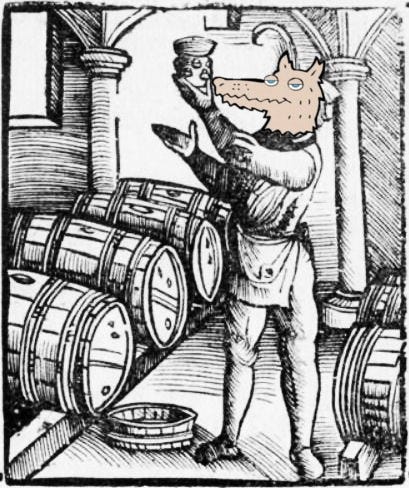Is a versipellis really a werewolf?
Yes, but it’s not just that. Jupiter is called versipellis in Plautus’s Amphitryon because he changed his appearance to the titular character. In Apuleius’s Metamorphoses, witches are called versipelles because they can change into whatever animal they want in order to deceive humans. More metaphorically, a person who changes themselves to suit their company or present circumstance is termed vorsipellem by Plautus in his Bacchides. There are examples of people who literally or metaphorically change their skin: vertere + pellem.
And what is a werewolf but that? We see versipellis applied to werewolf in the well-known tale relayed to us by Petronius. Pliny, who discusses werewolves in a chapter of his Naturalis Historia also gives them this name. We have lycanthropus as a Late Latin word if we want to use it, but I know of no name specifically and exclusively for werewolves in Classical Latin. Please comment if you do!
What did Pliny believe about werewolves?
Recently, I’ve been reading more supernatural stories from medieval Europe. The Byland Abbey ghost stories, full of zombie-like spectres that return from the dead, are treated with very limited skepticism by the anonymous author—the reader gets the feeling they did believe what they are writing down. William of Newburgh, writing around the same time and about the same place, acknowledges that the stories of ghoulish revenants he relates in his Historia rerum Anglicarum are difficult to believe, but he adds that there are so many such stories with so many witnesses he felt compelled to write them down as a warning of posterity.
But Pliny? Pliny was downright skeptical of his supernatural material when it came to werewolves, and he outright rejected the veracity of such tales, saying:
Homines in lupos verti rursusque restitui sibi falsum esse confidenter existimare debemus aut credere omnia quae fabulosa tot saeculis conperimus.
“That people turn into wolves and again are restored [to their original form] we should confidently regard as untrue, unless we should believe all the things we have proven to be fictitious for so many ages.”
(Yes, I appreciate the irony of this considering the many other fabulosa things related in Naturalis Historia as fact.)
A tiered text of Northern werewolves
In the chapter of his work Historia De Gentibus Septentrionalibus on werewolves, Olaus Magnus cities this passage from Pliny about the non-existence of werewolves and acknowledges his skepticism—then he immediately goes on to say, but oh man, do we have a bunch of werewolves up here! It’s Olaus’s chapter on lycanthropes that I chose to make a three-tiered version of. I selected this story because there are already so many different adaptations of the Petronius tale, and besides, the werewolves in Northern Europe have very particular habit: 🍺. The easiest tier, called Interpretatio III in this document, can probably be read if you have the level of Latin necessary to complete chapter 11 of Familia Romana. There are also marginal notes and images in Latin to help you out!
The tiered text on werewolves from Olaus Magnus’s Historia De Gentibus Septentrionalibus:
Curate ut optime valeatis!
P.S. An interesting tidbit from Pliny about werewolves’ tails that he totally didn’t believe:
Quin et caudae huius animalis creditur vulgo inesse amatorium virus exiguo in villo eumque, cum capiatur, abici nec idem pollere nisi viventi dereptum.
“It is also commonly believed that in the tail of this animal there is an erotic power in a single small hair, and when the creature is caught, this hair is shed, but it does not have this same power unless it it procured while the creature is alive.” ❤️🐺







I had no idea that werewolves loved beer so much, nor that they make turrets out of the casks when they're done. Truly terrifying...